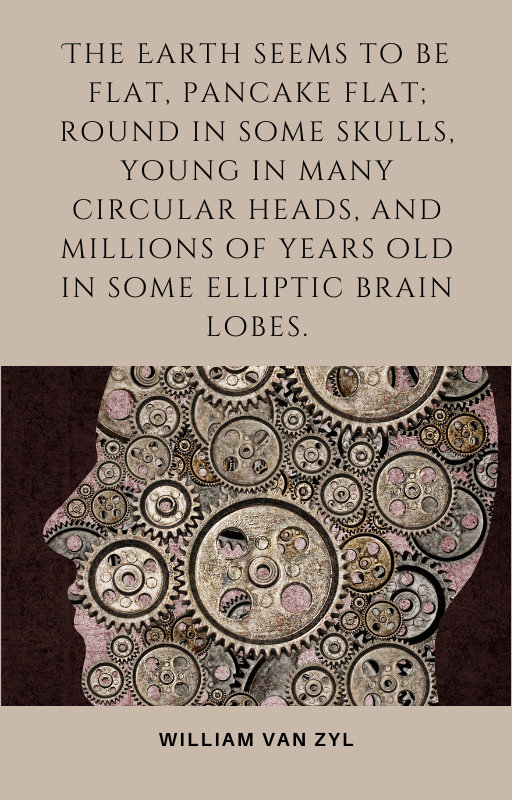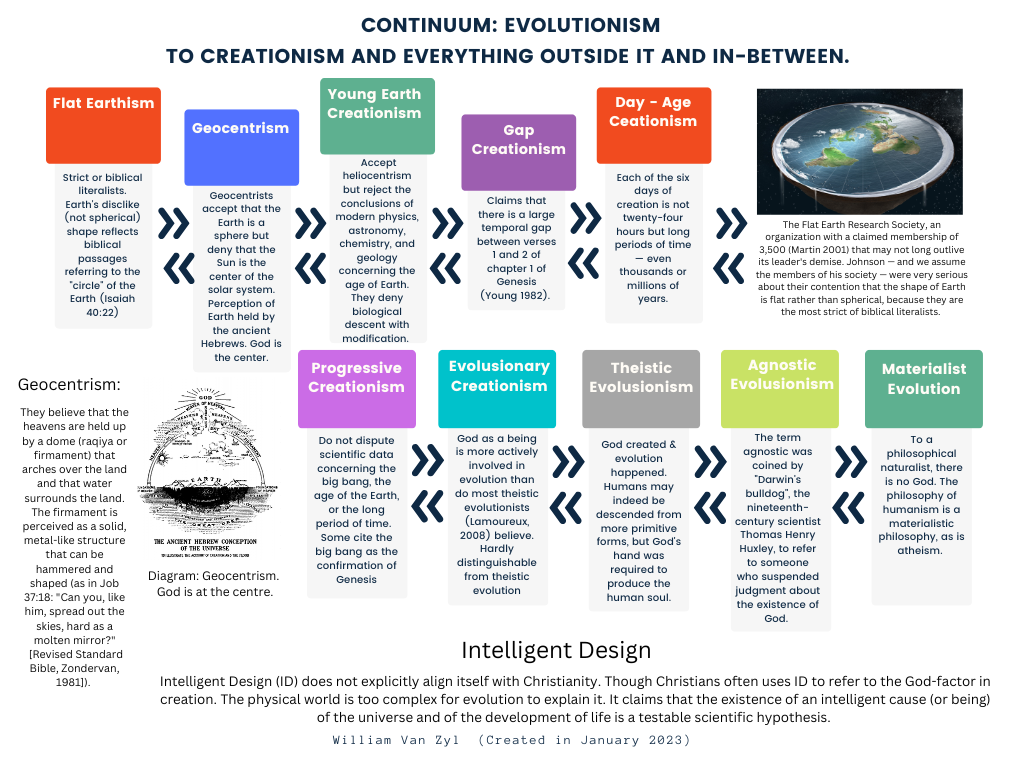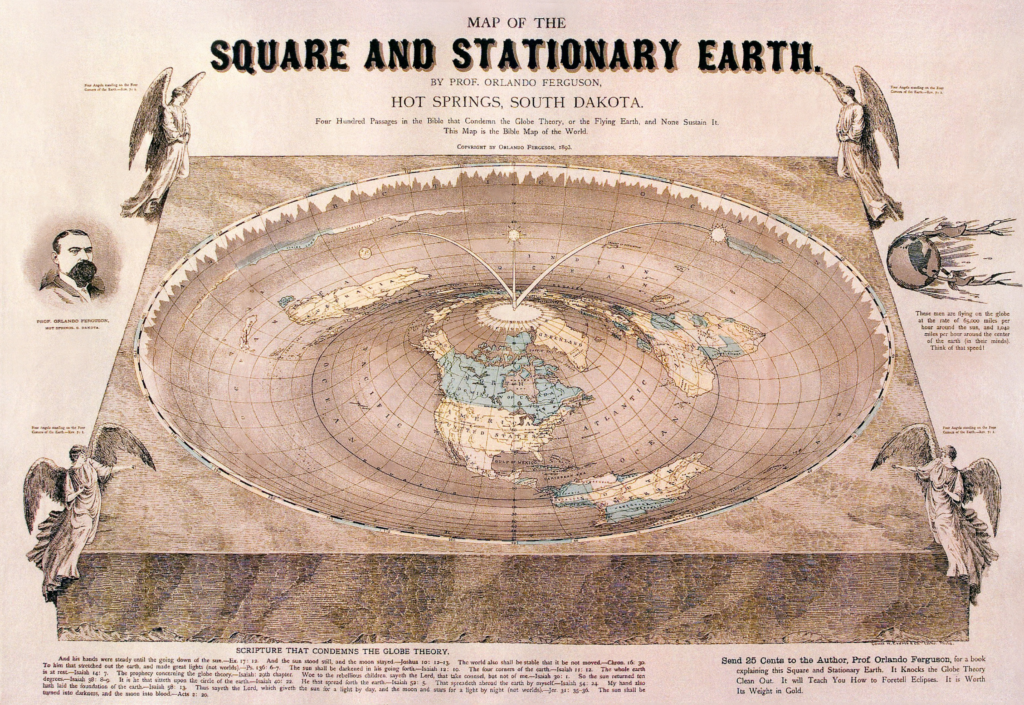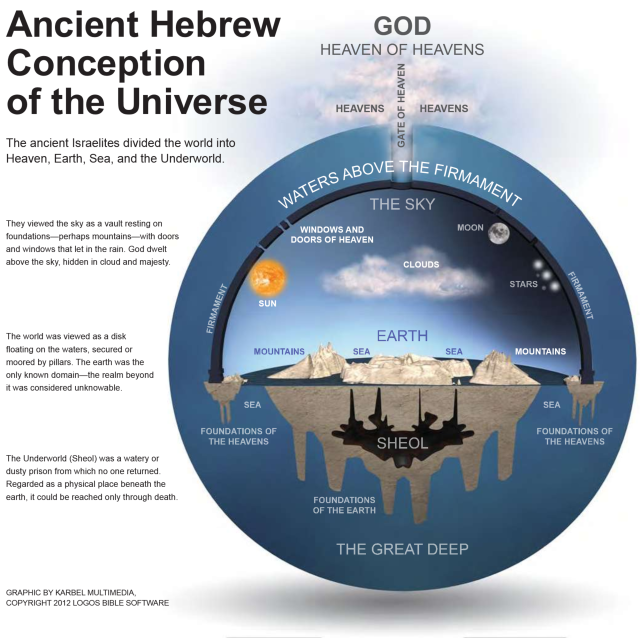
By William Van Zyl
Published January 17, 2023

We are all very different from one another. Our past, upbringing, experiences, and religion have shaped our thinking and how we interpret the world. It is our own unique ‘fingerprint.’
Have you ever wondered what the thinking of your family, friends, and your neighbour look like? I am referring to where they are located on the Evolution-Creation continuum. Everyone sits somewhere on the continuum. Surprisingly research shows that it is not a black-or-white scenario: Either believing in Evolution or Creation. It is more complicated. We have to move away from this inaccurate dichotomy.
I have created a simple diagram – to make it very simple – you can identify your thinking from one page. See the chart in this concise article.
The National Centre for Science Education (NCSE) has identified many ways of thinking about how the physical world came about. It is our belief system that drives our thinking and our interpretation. Our paradigm, our beliefs, our construct, our philosophy.
I am sure you are already thinking, ‘where will I fit into this Evolution-Creation continuum?’ Let’s not waste any more time. You can quickly and effortlessly identify where you sit in these paradigm ranges.
Whether you are Christian, Agnostic, Atheist, Scientist, or practicing any other religion (or no religion), you could find out where your thinking sits.
Here is the diagram:

Table of Contents
Flat Earthism:
Strict or biblical literalists. Earth’s disc-like (not spherical) shape reflects biblical passages referring to the “circle” of the Earth (Isaiah 40:22)
I am fascinated by the flat earth theory. Love the pictures, it is so cool. I cannot resist including 2 of them.
Isaiah 40:22 — King James Version (KJV 1900)
22 It is he that sitteth upon the circle of the earth,
And the inhabitants thereof are as grasshoppers;
That stretcheth out the heavens as a curtain,
And spreadeth them out as a tent to dwell in:


Geocentrism:
Geocentrists accept that Earth is a sphere but deny that the Sun is the center of the solar system. Perception of Earth held by the ancient Hebrews. God is the center.
I can’t resist including this image of the ancient Hebrews’ concept of the Universe. So interesting! The verse ‘FOUNDATIONS OF THE EARTH’ grabbed my attention. You will not believe how many verses refer to the foundations of the earth! I found 32 references to the foundations of the earth. Here is one of the verses:
Then the channels of waters were seen, and the foundations of the world were discovered at thy rebuke, O LORD, at the blast of the breath of thy nostrils. Psalm 18:15.

Young Earth Creationism:
Accept heliocentrism but reject the conclusions of modern physics, astronomy, chemistry, and geology concerning the age of Earth, and they deny biological descent with modification.
Gap Creationism:
Claims there is a significant time gap between verses 1 and 2 of chapter 1 of Genesis (Young 1982).
Day-Age Creationism:
Each of the six days of creation is not twenty-four hours but extended periods of time — even thousands or millions of years.
Progressive Creationism:
Do not dispute scientific data concerning the big bang, the age of Earth, or the long period of time. Some cite the big bang as the confirmation of Genesis.
Evolutionary Creationism:
God as a being is more actively involved in evolution than most theistic evolutionists (Lamoureux, 2008) believe. Hardly distinguishable from theistic evolution.
Theistic Creationism:
God created & evolution happened. Humans may indeed be descended from more primitive forms, but God’s hand was required to produce the human soul.
Agnostic Evolutionism:
The term agnostic was coined by “Darwin’s bulldog”, the nineteenth-century scientist Thomas Henry Huxley, to refer to someone who suspended judgment about the existence of God.
Materialist Evolution:
To a philosophical naturalist, there is no God. The philosophy of humanism is a materialistic philosophy, as is atheism.
What is the difference between an Atheist and an Agnostic?
Technically, an atheist is someone who doesn’t believe in a god, while an agnostic is someone who doesn’t believe it’s possible to know for sure that a god exists. It’s possible to be both—an agnostic atheist doesn’t believe but also doesn’t think we can ever know whether a god exists.
What is a Theist?
A Theist is a believer in theism: a person who believes in the existence of a god or gods.
Specifically one who believes in the existence of one God viewed as the creative source of the human race.
We are unique in our thinking:
We are all very different from one another. Our past, upbringing, experiences, and religion have shaped our thinking and how we interpret the world. It is our own unique ‘fingerprint.’
We have to celebrate who we are. However, it is good to know how others think and how they interpret our world. It is our personal paradigm (pattern or model).
Christians also have different interpretations. However, the one essential thing that unites believers is that they are all children of God. Christ died on the cross for them. His Blood redeems them. They are His people. They are ‘saved’ and will receive eternal life.
Additional diagram showing Old Earth and Young Earth. See the intelligent design component slicing through all of them. The evidence of Intelligent Design is increasing as science discovers and unveils more. Credit: https://ncse.ngo/creationevolution-continuum
How do you change a paradigm?
Let’s look at the concepts of Bob Proctor (July 5, 1934 – February 3, 2022). He was a Canadian self-help author and lecturer. Here is his theory in a nutshell and how to change a paradigm (Proctor, n. d.).
- Think about a result you’re getting that you don’t want and ask yourself what behaviours or habits are causing that result.
- Write the behaviour out in crystal clear detail.
- Ask yourself what habit or behaviour is the polar opposite of the behaviour you just identified.
- Write out the new behaviour on another sheet of paper.
- Burn the paper that contains the bad habit (as a symbolic gesture).
- Write the positive habit out four or five times a day. Read it frequently. You will eventually lodge that idea in your subconscious mind.
Link: https://www.proctorgallagherinstitute.com/6104/how-to-change-a-paradigm
It seems like once the new concepts and beliefs begins to take root, it takes power away from the bad habits, and the bad habits actually dies from lack of nourishment. Then, the deposited one takes over.
Now it will take a fair amount of energy and understanding to do these things, but it seems like it will be worth the effort because it will allow you to write your own destiny in life. Right?
Allow me also to include a Christian take on paradigm change and management.
Whatever you feed your eyes and your ears will impact on your mind. Then it will drop down into your heart and become your paradigm (philosophy). Once you believe it, you will live it.
Keep this Book of the Law always on your lips; meditate on it day and night, so that you may be careful to do everything written in it. Then you will be prosperous and successful. Joshua 1:8 (NIV).
Here are 2 verses that explain how the heart is the center from which we live our lives. Guard it! What we place into our paradigm will govern our being. The shaping of our paradigm comes through our ears and our eyes – it falls our minds – and then drops into our hearts (our belief). That’s who we are.
For as he thinketh in his heart, so is he… (Proverbs 23:7 KJV).
King Solomon said it best: “Above all else, guard your heart, for it is the wellspring of life” (Proverbs 4:23).
Dear reader, what is in your heart? What does your paradigm looks like. Why not make a simple sketch or diagram. Summarising your paradigm will allow you to reflect on your past – in other words, what shaped you thoughts – think about all the repetitions during your childhood. Once you are done look at the diagram, be critical about what you have allowed into your heart (or not allowed). Do you want to make some changes, or are your paradigm just fine?

This picture speaks of a Christian who has found perfect peace and eternal salvation through the death of our Lord and Saviour, Jesus Christ. This text copied from site Heart Of Man https://angp-hb.co.za.
Read more: BIBLE TOPIC – HEART OF MAN https://angp-hb.co.za
References:
Scott EC, Cole HP. The elusive basis of creation “science”. Quarterly Review of Biology 1985; 60: 21-30.
Proctor, B. (n. d.). How to Change a Paradigm. Proctor Gallagher Institute. https://www.proctorgallagherinstitute.com/6104/how-to-change-a-paradigm
Citation:
Van Zyl, W.N. (2023). The Earth seems to be flat, pancake flat; round in some skulls, young in many circular heads, and millions of years old in some elliptic brain lobes. Published to Five House Publishing (article): https://fivehousepublishing.com/2023/01/17/the-earth-seems-to-be-flat-pancake-flat-round-in-some-skulls-young-in-many-circular-heads-and-millions-of-years-old-in-some-elliptic-brain-lobes/
Copyright © 2023 William Van Zyl
The Earth seems to be flat, pancake flat; round in some skulls, young in many circular heads, and millions of years old in some elliptic brain lobes
All rights reserved. This book or any portion thereof may not be reproduced or used in any manner whatsoever without the express written permission of the publisher except for the use of brief quotations in a book review.
New Zealand
First Publishing January 17, 2023
However, brief quotations in a book review, references to the website, links to the website, or very short references, may be used. Links to social media websites (Facebook, Twitter, etc.) may be used. The photographs/sketches may not be reproduced.
More articles: https://fivehousepublishing.com/blog-posts-grid-view/
Read more online: https://fivehousepublishing.com/
More about the Author: http://williamvanzyl.com/
Podcasts:
The Extravagant Podcast. Available on Spotify, Podbean, Audible, and more.

https://feed.podbean.com/williamvzyl/feed.xml
https://williamvzyl.podbean.com/